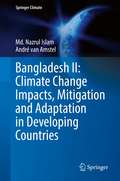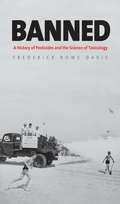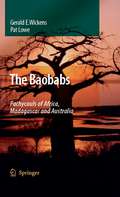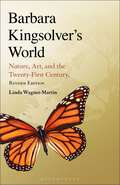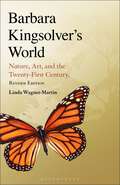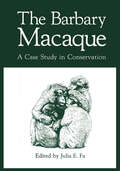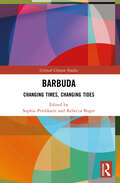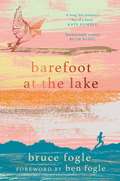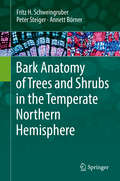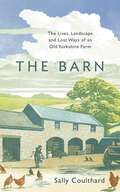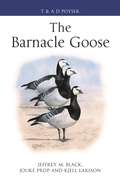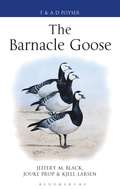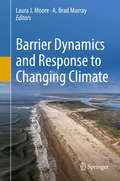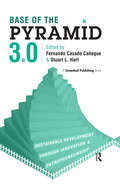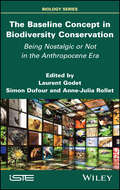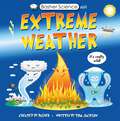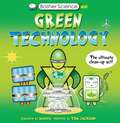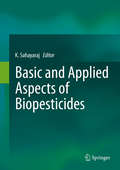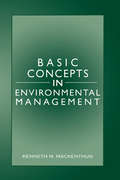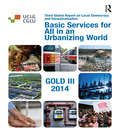- Table View
- List View
Bangladesh II: Climate Change Impacts, Mitigation and Adaptation in Developing Countries (Springer Climate)
by Md. Nazrul Islam André van AmstelThis volume aims to develop a framework for disaster and climate risk resilient livelihood system in Bangladesh using a policy oriented approach. It highlights the possible impacts of climate change on groundwater based irrigation in the country. Climate change is one of biggest challenges to society. It can lead to serious impacts on production, life and environment on a global scale. Higher temperatures and sea level rise will cause flooding and water salinity problems which will bring about negative effects on agriculture and high risks to industry and socio-economic systems in the future. Climate change will lead to many changes in global development and security especially energy, water, food, society, job, diplomacy, culture, economy and trade. The Intergovernmental Panel on Climate Change (IPCC) defines climate change as: “Any change in climate over time, whether due to natural variability or as a result of human activity.” Global climate change has emerged as a key issue in both political and economic arenas. It is an increasingly questioned phenomenon, and progressive national governments around the world have started taking action to respond to these environmental concerns.
Banned: A History of Pesticides and the Science of Toxicology
by Frederick Rowe DavisRachel Carson’s eloquent book Silent Spring stands as one of the most important books of the twentieth century and inspired important and long-lasting changes in environmental science and government policy. Frederick Rowe Davis thoughtfully sets Carson’s study in the context of the twentieth century, reconsiders her achievement, and analyzes its legacy in light of toxic chemical use and regulation today. Davis examines the history of pesticide development alongside the evolution of the science of toxicology and tracks legislation governing exposure to chemicals across the twentieth century. He affirms the brilliance of Carson’s careful scientific interpretations drawing on data from university and government toxicologists. Although Silent Spring instigated legislation that successfully terminated DDT use, other warnings were ignored. Ironically, we replaced one poison with even more toxic ones. Davis concludes that we urgently need new thinking about how we evaluate and regulate pesticides in accounting for their ecological and human toll.
The Baobabs: Pachycauls of Africa, Madagascar and Australia
by G.E. WickensThis is the only comprehensive account of all eight species in the genus Adansonia. It describes the historical background from the late Roman period to the present. It covers the extraordinary variety of economic uses of baobabs. There are also appendices on vernacular names, gazetteer, economics, nutrition and forest mensuration. This book fills a gap in the botanical literature. It deals with a genus that has fascinated and intrigued scientists and lay persons for centuries.
Barbara Kingsolver's World: Nature, Art, and the Twenty-First Century, Revised Edition
by Prof Linda Wagner-MartinA revised edition of Linda Wagner-Martin's comprehensive study of the novels, stories, essays and poetry of American author Barbara Kingsolver. Now updated so that coverage runs from Kingsolver's first novel, The Bean Trees, through to her most recent, Demon Copperhead. Author of the only biography of Barbara Kingsolver and of a reader's guide to The Poisonwood Bible, Wagner-Martin has become the leading authority on this Pulitzer-prize-wining author. Here she covers every work in Kingsolver's oeuvre, emphasizing the writer's blend of the scientific method in which she was formally trained with her convincing understanding of the human characters that fill her books. What Kingsolver achieves throughout all her writing is a seamless blending of the various parts of human existence. She melds important themes through parts and pieces of the natural world-the African snakes, the Monarch butterflies, the coyotes in Deanna Wolfe's existence. Repeatedly Kingsolver writes to create both characters and the characters' worlds, bringing all these pieces into masterful, and whole, realities.This edition includes two new chapters - one on her 2018 novel, Unsheltered, and the second on her 2022 novel, Demon Copperhead - and is the first study of Kingsolver to publish since she was awarded the Pulitzer Prize for Fiction in 2023.
Barbara Kingsolver's World: Nature, Art, and the Twenty-First Century, Revised Edition
by Prof Linda Wagner-MartinA revised edition of Linda Wagner-Martin's comprehensive study of the novels, stories, essays and poetry of American author Barbara Kingsolver. Now updated so that coverage runs from Kingsolver's first novel, The Bean Trees, through to her most recent, Demon Copperhead. Author of the only biography of Barbara Kingsolver and of a reader's guide to The Poisonwood Bible, Wagner-Martin has become the leading authority on this Pulitzer-prize-wining author. Here she covers every work in Kingsolver's oeuvre, emphasizing the writer's blend of the scientific method in which she was formally trained with her convincing understanding of the human characters that fill her books. What Kingsolver achieves throughout all her writing is a seamless blending of the various parts of human existence. She melds important themes through parts and pieces of the natural world-the African snakes, the Monarch butterflies, the coyotes in Deanna Wolfe's existence. Repeatedly Kingsolver writes to create both characters and the characters' worlds, bringing all these pieces into masterful, and whole, realities.This edition includes two new chapters - one on her 2018 novel, Unsheltered, and the second on her 2022 novel, Demon Copperhead - and is the first study of Kingsolver to publish since she was awarded the Pulitzer Prize for Fiction in 2023.
The Barbary Macaque: A Case Study in Conservation (Contributions To Primatology Ser. #Vol. 23)
by John E. FaThe Barbary macaque (all too often mistakenly called an ape) was first brought to the attention of the Conservation Working Party of the Primate Society of Great Britain late 1979 when John Fa reported that 'surplus' animals were being sent from Gibraltar to dubious locations, such as an Italian safari park. Since there had been no scientific input into the Army's management of the monkey colony on Gibraltar, and there was concern about inbreeding, nutrition and health - about the long-term viability of the colony, it was felt that the Society could help. The Gibraltar Scientific Authority and the Army were very receptive to our offer and ideas, and this topic occupied successive chairmen over the last few years - Robin Dunbar and Richard Wrangham, myself and now Miranda Stevenson - with constant prompting and help from John Fa. Considerations soon extended to the status of the species as a whole, so that there have been three main aspects:- (1) the improved health of a larger self-sustaining population on Gibraltar, (2) the status and behavioural biology of natural populations in North Africa (Morocco and Algeria), and (3) the breeding achievements in European parks and zoos, and their potential for reintroduction to suitable areas in North Africa, along with other possibilities. Robin Dunbar organized the compilation of recommendations for managing the Gibraltar colony with regard to numbers, age-sex struc ture and behavioural relationships, with some observations on diet to avoid obesity and infertility.
Barbuda: Changing Times, Changing Tides (Critical Climate Studies)
by Sophia Perdikaris Rebecca BogerThis volume explores a range of themes including impacts of climate change, resilience, sustainability, indigeneity, cultural genocide, disaster capitalism, preservation of biodiversity, and environmental degradation. Focusing on the island of Barbuda in the West Indies, it shares critical insights into how climate change is reshaping our world. The book examines how climate has changed in the Caribbean over different spatial and temporal scales and how varying natural and anthropogenic factors have shaped Barbuda’s climatic and cultural history. It highlights projections of 21st-century climate change for the Caribbean region and its likely impacts on Barbuda’s coastal ecosystems, potable groundwater resources, and heritage. With essays by researchers from the United States, Canada, Caribbean, and Europe, this volume straddles a range of disciplines such as archaeology, anthropology, paleoclimatology, environmental sciences, science education, and Traditional Ecological Knowledge (TEK). Drawing on interdisciplinary and transdisciplinary approaches that explore the intersection of natural and social systems over the longue durée, the volume will be of interest to scholars, researchers, and students of ethnography, social anthropology, climate action, development studies, public policy, and climate change.
Barbuda: Changing Times, Changing Tides (Critical Climate Studies)
by Sophia Perdikaris and Rebecca BogerThis volume explores a range of themes including impacts of climate change, resilience, sustainability, indigeneity, cultural genocide, disaster capitalism, preservation of biodiversity, and environmental degradation. Focusing on the island of Barbuda in the West Indies, it shares critical insights into how climate change is reshaping our world. The book examines how climate has changed in the Caribbean over different spatial and temporal scales and how varying natural and anthropogenic factors have shaped Barbuda’s climatic and cultural history. It highlights projections of 21st-century climate change for the Caribbean region and its likely impacts on Barbuda’s coastal ecosystems, potable groundwater resources, and heritage. With essays by researchers from the United States, Canada, Caribbean, and Europe, this volume straddles a range of disciplines such as archaeology, anthropology, paleoclimatology, environmental sciences, science education, and Traditional Ecological Knowledge (TEK). Drawing on interdisciplinary and transdisciplinary approaches that explore the intersection of natural and social systems over the longue durée, the volume will be of interest to scholars, researchers, and students of ethnography, social anthropology, climate action, development studies, public policy, and climate change.
Barefoot at the Lake: A Memoir Of Summer People And Water Creatures
by Bruce FogleA beautiful memoir of summer people and water creatures, which illustrates the formative effects of nature on children by an author who has forged a career caring for animals. For readers of Raynor Winn's THE SALT PATH, John Lewis-Stemple's STILL WATER and Gerald Durrell's MY FAMILY AND OTHER ANIMALS.Year after year the family returns to the lake. The children, barefoot and free, explore its sun-drenched wilderness.Bruce Fogle recounts his childhood summers spent at the family cabin by the lake. In an atmospheric new foreword, Bruce's son, wildlife presenter Ben Fogle, shares his experiences spending summers in the very same cabin.The summer Bruce turns ten seems, at first, like any other: swimming out to the raft, watching the gulls, frogs and herons, catching crayfish. But just when he thinks that life is perfect, everything begins to change, and over the course of two months both the harshness of the adult world and the patterns of the natural world reveal themselves.Barefoot at the Lake is not only a beautifully written boy's-eye view of the animals, humans and landscape of his youth, it is also delightfully funny, with a moving wisdom at its heart.
Bark Anatomy of Trees and Shrubs in the Temperate Northern Hemisphere
by Fritz H. Schweingruber Peter Steiger Annett BörnerThis book presents the microscopic and macroscopic bark structure of more than 180 different tree and shrub species from Europe, Asia and North America. It is the first compendium to demonstrate the anatomical variability in bark since almost 70 years (Holdheide 1951). The introductory chapter explains with high-quality microphotographs the anatomical traits most important for identification and ecological interpretation of barks, and the monographic part demonstrates in text and pictures the species-specific patterns. The species treatments are grouped by their main biomes. Each species description first characterizes the macroscopic aspects with its main form, features and habitat with text and pictures of the whole plant and the barks in a young and old stage. This is followed by the microscopical description of each species. The microscopic photographs are based on double-stained slides, revealing the quality and distribution of unlignified and lignified tissues in low and high magnification. The book fills a scientific gap: Archeologists and soil scientists want to identify prehistoric and historical remnants. Ecophysiologists are interested in the distribution of conducting and non-conducting tissues in the phloem and xylem along the stem axis and the internal longevity of cells. Ecologists get information about internal defense mechanisms and technologists are enabled to recognize indicators relevant in biophysics and technology.
The Barn: The Lives, Landscape and Lost Ways of an Old Yorkshire Farm
by Sally CoulthardA revelatory uncovering of a vanished agricultural way of life by bestselling nature writer Sally Coulthard. 'A gem of a book' Country Smallholding 'Engaging and filled with gentle humour and fascinating facts' Get History 'Shows us the beauty and rich history of everyday things' Country Walking MagazineAcross the foldyard from Sally Coulthard's North Yorkshire farmhouse, stands an old stone barn. When she discovered a set of witches' marks on one of its internal walls, she began to wonder about the lives of the people who had once lived and worked there.Both the intimate story of a building and its hinterland, and a wider social history, The Barn explores a hidden corner of rural Britain that has witnessed remarkable changes. From the eighteenth-century Enclosures to the Second World War, the fortunes of the Barn have been blown, like a leaf in a gale, by the unstoppable forces of new agriculture and industry. Seismic shifts in almost every area of society were all played out here in miniature – against a backdrop of scattered limestone villages and the softly rolling Howardian Hills.
The Barnacle Goose
by Jeffrey M. Black Jouke Prop Kjell LarssonThe Barnacle Goose, a distinctive, handsome black-and-white bird, gets its name from a mediaeval myth that the birds hatched from barnacles – how else to explain their sudden appearance each autumn in northern Britain? We now know, of course, that the birds migrate from Arctic Russia, Norway and Svalbard to winter throughout northern Europe. This book represents a culmination of more than 25 years of Barnacle Goose research. It represents the story of one of Europe's most celebrated long-term behavioral studies, detailing the lives of these social and sociable birds. Chapters include sections on pair formation and bonding, family and population dynamics, brood parasitism, food and feeding, size and shape in different populations, life cycle, survivorship, dispersal, migration, and conservation, with particular regard to climate change. It is a rigorous and thorough examination of the lives of these birds, in fine Poyser tradition.
The Barnacle Goose
by Jeffrey M. Black Jouke Prop Kjell LarssonThe Barnacle Goose, a distinctive, handsome black-and-white bird, gets its name from a mediaeval myth that the birds hatched from barnacles – how else to explain their sudden appearance each autumn in northern Britain? We now know, of course, that the birds migrate from Arctic Russia, Norway and Svalbard to winter throughout northern Europe. This book represents a culmination of more than 25 years of Barnacle Goose research. It represents the story of one of Europe's most celebrated long-term behavioral studies, detailing the lives of these social and sociable birds. Chapters include sections on pair formation and bonding, family and population dynamics, brood parasitism, food and feeding, size and shape in different populations, life cycle, survivorship, dispersal, migration, and conservation, with particular regard to climate change. It is a rigorous and thorough examination of the lives of these birds, in fine Poyser tradition.
Barrier Dynamics and Response to Changing Climate
by Laura J. Moore A. Brad MurrayThis book presents chapters, written by leading coastal scientists, which collectively depict the current understanding of the processes that shape barrier islands and barrier spits, with an emphasis on the response of these landforms to changing conditions. A majority of the world’s population lives along the coast at the dynamic intersection between terrestrial and marine ecosystems and landscapes. As narrow, low-lying landforms, barriers are especially vulnerable to changes in sea level, storminess, the geographic distribution of grass species, and the rate of sand supply—some barriers will undergo rapid changes in state (e.g., from landward migrating to disintegrating), on human time scales. Attempts by humans to prevent change can hasten the loss of these landforms, threatening their continued existence as well as the recreational, financial and ecosystem service benefits they provide. Understanding the processes and interactions that drive landscape response to climate change and human actions is essential to adaptation. As managers and governments struggle to plan for the future along low-lying coasts worldwide, and scientists conduct research that provides useful guidance, this volume offers a much-needed compilation for these groups, as well as a window into the science of barrier dynamics for anyone who is generally interested in the impacts of a changing world on coastal environments.
Base of the Pyramid 3.0: Sustainable Development through Innovation and Entrepreneurship
by Fernando Casado Caneque Stuart L. HartFor well over 4 billion people – approximately 60% of all humanity – annual income is less than $1,500. The term "Base of the Pyramid" was first coined by Stuart L. Hart and C.K. Prahalad in 2002 and has become synonymous with both the method by which we can more effectively address poverty and the opportunity that exists in a multi-trillion-dollar market. A whole new lexicon has emerged to describe this phenomenon, including new buzzwords and catch phrases like "inclusive business", "opportunities for the majority", "sustainable livelihoods", "pro-poor business" and “social business”, and thousands of new businesses, institutions and investment funds have been set up.In this ground-breaking new book, Stuart L. Hart and Fernando Casado Cañeque have worked with members of the BoP Global Network to shake the tree, look objectively at what has happened since 2002, highlight why earlier applications of BoP haven’t worked and propose new objectives and ways of working to formulate more sustainable solutions. The book challenges the reader and organizations to think about the mindset and purpose across whole organizations, open innovation rather than simply co-creation, and a complete review of the innovation ecosystem. Through this book, practitioners will gain a clearer insight into which business models can work within different communities to ensure a sustainable transition to improved local economies. Equally, the book is a must-read for researchers and students in the fields of entrepreneurship, innovation, sustainable development and environmental management.
Base of the Pyramid 3.0: Sustainable Development through Innovation and Entrepreneurship
by Fernando Casado Caneque Stuart L. HartFor well over 4 billion people – approximately 60% of all humanity – annual income is less than $1,500. The term "Base of the Pyramid" was first coined by Stuart L. Hart and C.K. Prahalad in 2002 and has become synonymous with both the method by which we can more effectively address poverty and the opportunity that exists in a multi-trillion-dollar market. A whole new lexicon has emerged to describe this phenomenon, including new buzzwords and catch phrases like "inclusive business", "opportunities for the majority", "sustainable livelihoods", "pro-poor business" and “social business”, and thousands of new businesses, institutions and investment funds have been set up.In this ground-breaking new book, Stuart L. Hart and Fernando Casado Cañeque have worked with members of the BoP Global Network to shake the tree, look objectively at what has happened since 2002, highlight why earlier applications of BoP haven’t worked and propose new objectives and ways of working to formulate more sustainable solutions. The book challenges the reader and organizations to think about the mindset and purpose across whole organizations, open innovation rather than simply co-creation, and a complete review of the innovation ecosystem. Through this book, practitioners will gain a clearer insight into which business models can work within different communities to ensure a sustainable transition to improved local economies. Equally, the book is a must-read for researchers and students in the fields of entrepreneurship, innovation, sustainable development and environmental management.
The Baseline Concept in Biodiversity Conservation: Being Nostalgic or Not in the Anthropocene Era
by Laurent Godet Simon Dufour Anne-Julia RolletThe Anthropocene era has been marked by such significant human pressure that it has led to the sixth mass extinction. The Baseline Concept in Biodiversity Conservation interprets human domination of the Earth as the process of gradual landscape change, the execution of which is neither linear nor homogeneous. This book is structured around three key questions: Where and when did everything go wrong? How do we define baseline states for biodiversity conservation strategies? How are reference states mobilized in a concrete way through case studies? Today, biodiversity conservation faces a dilemma that this book sheds light on: return to states less modified by humans than today but in a world that has changed significantly; or, let the nature of tomorrow express itself where it still can but without a road map.
The Baseline Concept in Biodiversity Conservation: Being Nostalgic or Not in the Anthropocene Era
by Laurent Godet Simon Dufour Anne-Julia RolletThe Anthropocene era has been marked by such significant human pressure that it has led to the sixth mass extinction. The Baseline Concept in Biodiversity Conservation interprets human domination of the Earth as the process of gradual landscape change, the execution of which is neither linear nor homogeneous. This book is structured around three key questions: Where and when did everything go wrong? How do we define baseline states for biodiversity conservation strategies? How are reference states mobilized in a concrete way through case studies? Today, biodiversity conservation faces a dilemma that this book sheds light on: return to states less modified by humans than today but in a world that has changed significantly; or, let the nature of tomorrow express itself where it still can but without a road map.
Basher Science Mini: It's really wild!
by Tom JacksonThings are hotting up, but not in a good way! Every year, millions of people across the globe find themselves at the mercy of Heat Wave, Drought or Flood – they’re friends of Climate Change, who is wreaking havoc on our planet.Step inside to learn more about these extreme characters. But first, let Weather System, Seasons and Climate tell you how weather works. Find out just what it is about Climate Change that is making things more intense. And whatever you do, don’t panic! Just as there are troublemakers in this turbulent world, there are heroes who want to calm things down: Flood Defences and Firefighting will bring you up to speed.Basher Science Mini: Extreme Weather gives kids the lowdown on one of the most pressing problems that we face: extreme weather. Basher's unique illustrations combine with chatty, first-person text by expert author Tom Jackson to hook even the most reluctant readers and help them to understand the science behind the headlines.Perfect for home or school, Basher's highly original books make difficult concepts tangible, understandable and even lovable. With sales of over 3 million copies around the world, they are a brilliant way to communicate science, history and geography.
Basher Science Mini: Green Technology (Basher #138)
by Tom JacksonWorld, we’ve got a problem! Climate Change. Make that two problems as Pollution is in the frame. In Basher Science Mini: Green Technology, scientific wizardry rides to the planet’s rescue. From saving the birds and the bees, to cleaning up the seas and waving goodbye to plastics, green tech is part of the solution to climate change. Some solutions are really out there, take a bow Space Mirrors, while others are close to home, we see you, Solar Panels! And you, too, Electric Vehicle! Our motto is protect and repair. Let’s get started.Perfect for home or school, Basher's highly original books make difficult concepts tangible, understandable and even lovable. Chatty first-person text and stylish, contemporary character illustrations give a voice, personality and story to each topic – a brilliant way to communicate science.
Basic and Applied Aspects of Biopesticides
by K. SahayarajCurrently, the major challenge of humanity is focused on population growth through agricultural production in order to meet the demand for food. The food crunch is mainly due to pest and disease. Traditional methods, synthetic insecticides and microbicides cause health hazards to human beings, domestic animals and also affect our immediate environments. Serious concerns were implemented by both developing and developed countries as Integrated Pest Management (IPM) and Bio-intensive Integrated Pest Management (BIPM) systems where biopesticides play an important role worldwide. The available books are limited to particular aspects of biopesticides. Hence, it is imperative to bring out a holistic documentation which will provide the reader information on all aspects of biopesticides. The book consists of five sections namely microbials, botanicals, natural enemies semio- chemicals and biotechnology and equipments, bioinformatics tools and IPM. In Section I, microbial deals with utilization of Bacillus in control of phytonematodes; biological control of pest and diseases with fluorescent pseudomonads, entomopathogenic fungus and entomopathogenic nematodes in pest management, microbial viral insecticides and microbial elicitors to induce immunity for plant disease control in chilli and tomato. Importance of plant essential oils, botanicals in endocrine disruption, relevance of botanicals and use of plant volatile on pest management has been discussed in Section II. Importance and role of reduviidae, weaver ants, ground beetles, Odonatas, spiders in biological control has been discussed in Section III. In addition, genetic improvement of biocontrol agents for sustainable pest management has also been highlighted. In Section IV, classical practices and pheromone, kairomonal enhancement to natural enemies and use of transgenic plants in insect control are highlighted. Equipment and their application methodologies for application of biopesticides; relevance of bioinformatics in biopesticides management; pest management of soybean, bio fouling and eco friendly antifoulants have been highlighted in Section V. Each chapter has objectives and conclusion along with recommendations.
Basic Concepts in Environmental Management
by Kenneth M. MackenthunEnvironmental professionals are (and will continue to be) under increased pressure to become more knowledgeable of environmental management issues.Basic Concepts in Environmental Management fulfills the long-standing need for fundamental knowledge-especially concerning government regulations on environmental and natural resource protection.As a leading environmental professional and consultant since the 1940s, Kenneth M. Mackenthun offers a unique perspective on the breadth, scope, and ever-constant change in environmental legislation at the federal, state, and local levels... and what those guidelines signify for industry and citizens alike.By maintaining an awareness of existing and forthcoming laws, environmentalists can substantially enhance their career potential-and be in a better position to protect the land, air, and sea. The starting point for that knowledge: Basic Concepts in Environmental Management.
Basic Concepts in Environmental Management
by Kenneth M. MackenthunEnvironmental professionals are (and will continue to be) under increased pressure to become more knowledgeable of environmental management issues.Basic Concepts in Environmental Management fulfills the long-standing need for fundamental knowledge-especially concerning government regulations on environmental and natural resource protection.As a leading environmental professional and consultant since the 1940s, Kenneth M. Mackenthun offers a unique perspective on the breadth, scope, and ever-constant change in environmental legislation at the federal, state, and local levels... and what those guidelines signify for industry and citizens alike.By maintaining an awareness of existing and forthcoming laws, environmentalists can substantially enhance their career potential-and be in a better position to protect the land, air, and sea. The starting point for that knowledge: Basic Concepts in Environmental Management.
Basic Services for All in an Urbanizing World
by United Cities And Local Governments StaffUCLG’s Third Global Report on Local Democracy and Decentralization (GOLD III) examines basic service provision and the current state-of-play of the local governance of basic services around the world. Basic Services for All in an Urbanizing World examines the enormous challenge of ensuring the universal provision of basic services in a world that is being shaped by rapid global urbanization, climate change, and economic, social and technological transformation. The world’s urban population is predicted to reach 5 billion people within the next 20-30 years. The report analyses the conditions necessary for local governments to provide these new urban residents with quality basic services. Water, sanitation, waste management, transport and energy are essential, not only for the preservation of human life and dignity, but also in driving economic growth and ensuring social equality. Each chapter examines a world region, drawing on existing research and consultation with local authorities on the ground. The chapters review access levels, legal and institutional frameworks, and the different ways in which basic services are managed and financed, as well as showcasing diverse examples of innovation in the local and multi-level governance of services. It concludes with a set of recommendations for all stakeholders with a view to making the goal of basic services for all a reality. This report contributes to discussions on the Millennium Development Goals and the UN Post-2015 Development Agenda. The findings of GOLD III will also be essential to promoting the vision of local governments at the 2016 UN Conference on Human Settlements (Habitat III).
Basic Services for All in an Urbanizing World
by UclgUCLG’s Third Global Report on Local Democracy and Decentralization (GOLD III) examines basic service provision and the current state-of-play of the local governance of basic services around the world. Basic Services for All in an Urbanizing World examines the enormous challenge of ensuring the universal provision of basic services in a world that is being shaped by rapid global urbanization, climate change, and economic, social and technological transformation. The world’s urban population is predicted to reach 5 billion people within the next 20-30 years. The report analyses the conditions necessary for local governments to provide these new urban residents with quality basic services. Water, sanitation, waste management, transport and energy are essential, not only for the preservation of human life and dignity, but also in driving economic growth and ensuring social equality. Each chapter examines a world region, drawing on existing research and consultation with local authorities on the ground. The chapters review access levels, legal and institutional frameworks, and the different ways in which basic services are managed and financed, as well as showcasing diverse examples of innovation in the local and multi-level governance of services. It concludes with a set of recommendations for all stakeholders with a view to making the goal of basic services for all a reality. This report contributes to discussions on the Millennium Development Goals and the UN Post-2015 Development Agenda. The findings of GOLD III will also be essential to promoting the vision of local governments at the 2016 UN Conference on Human Settlements (Habitat III).
